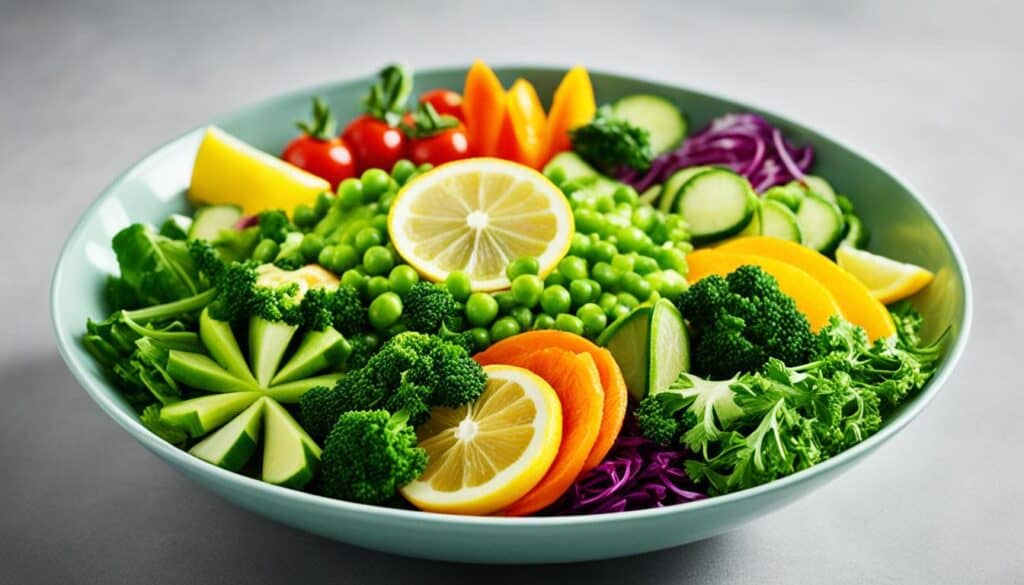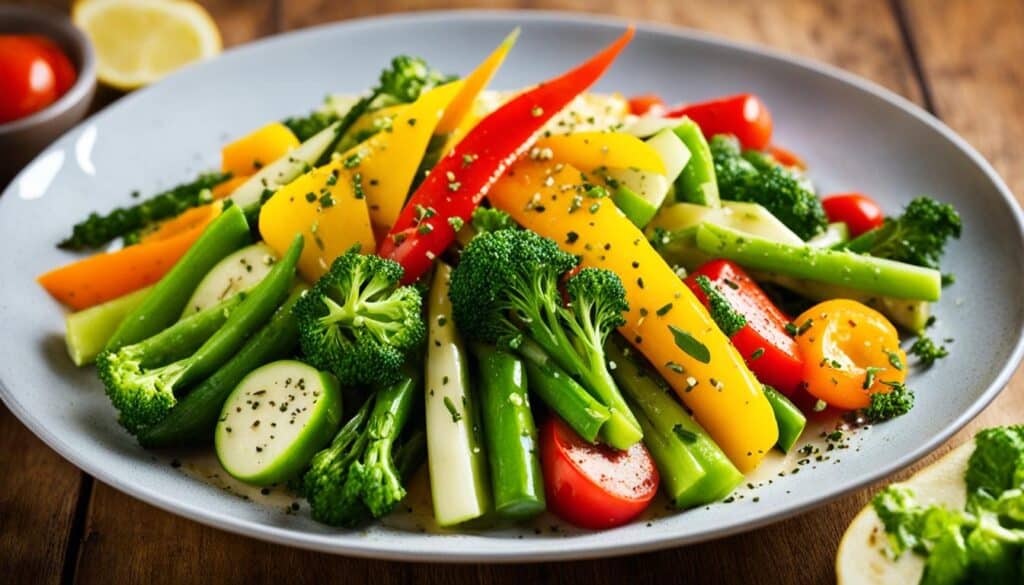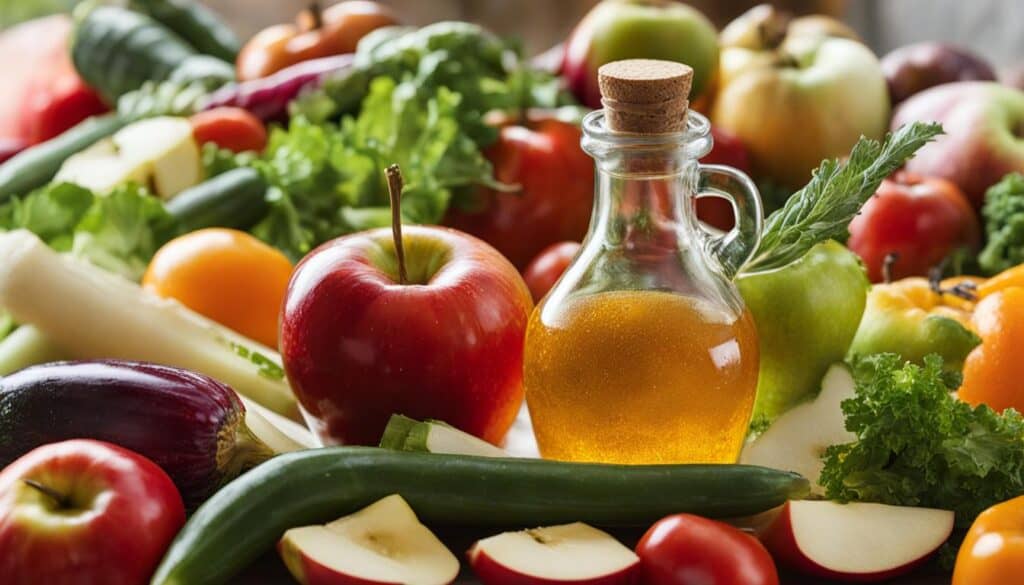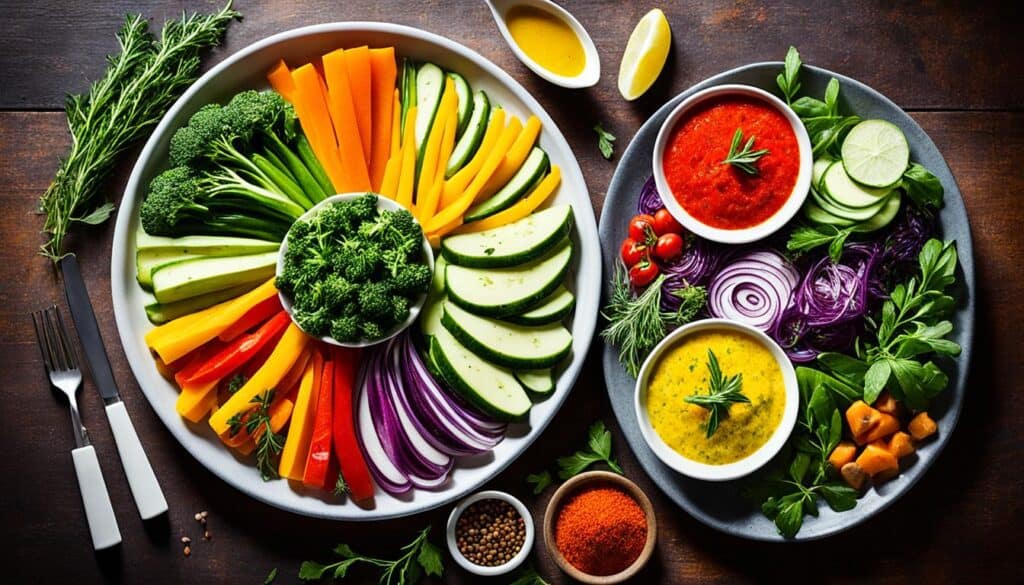Did you know that steaming vegetables is not only a healthy cooking method, but it also retains more nutrients compared to other cooking methods? When you steam vegetables, they retain their natural flavors and textures while preserving their valuable vitamins and minerals. It’s time to discover the secrets to making your steamed vegetables fresh and flavorful!
Key Takeaways:
- Steaming vegetables helps to retain their natural flavors and nutrients.
- By adding fresh herbs and aromatics, you can enhance the taste and aroma of steamed veggies.
- Citrus, olive oil, sesame oil, fish sauce, soy sauce, and vinegar are all great ingredients to experiment with when it comes to steamed vegetables.
- Don’t be afraid to get creative and add toppings, nuts, cheeses, dressings, and spices to give your steamed vegetables a delicious makeover.
- Steamed vegetables are a healthy and nutritious addition to any balanced diet.
Adding Fresh Herbs
Adding fresh herbs to steamed vegetables can elevate their taste and aroma. You can toss whole sprigs of herbs like parsley, thyme, or dill over the steaming vegetables, or chop up the leaves and sprinkle them over the veggies after they’re cooked. The herbs not only add a burst of flavor but also contribute to the nutritional value of the dish. Experiment with different herbs to find your favorite combinations.
Infusing with Aromatics
When it comes to adding an extra zing to your steamed vegetables, infusing them with aromatics like garlic and ginger can take their flavor to the next level. Whether you want to enhance the taste of any vegetable or specifically boost leafy greens like kale, these aromatic ingredients work wonders.
Sliced or chopped garlic is a versatile addition that pairs well with almost any vegetable. However, its earthy and pungent flavor complements leafy greens particularly well. To maximize the garlic’s flavor, consider sautéing it in olive oil before tossing it with the steamed veggies. The heat will release its rich aroma, intensifying the overall taste.
“The sautéed garlic adds depth and complexity to the steamed vegetables, making each bite a burst of flavor,” says Chef Emma.
Apart from garlic, thinly sliced ginger can lend a delightful twist to your steamed veggies. Try placing the ginger at the bottom of the steaming basket and cover it with vegetables like butternut squash or other root vegetables. As the steam rises, it will gently infuse the vegetables with the warm and slightly peppery essence of ginger, resulting in a delicious combination.
Tips for Infusing Steamed Vegetables with Aromatics:
- Experiment with different vegetables to discover your favorite flavor combinations.
- Don’t be afraid to adjust the amount of garlic and ginger according to your taste preferences.
- Sauté the garlic in olive oil until golden for a richer flavor.
- Consider using fresh ginger for a more vibrant and aromatic profile.
By infusing your steamed vegetables with these aromatic ingredients, you can elevate their taste and aroma, adding a delicious twist to an already nutritious dish.
Adding Citrus
Adding citrus to steamed vegetables can bring a bright and refreshing flavor to the dish. The acidity of citrus fruits like lemon cuts through the richness of the vegetables and adds a subtle tanginess to the overall taste. There are a few ways to incorporate citrus into your steamed veggies:
- Add Lemon Slices: You can enhance the flavor of vegetables like broccoli, green beans, and summer squash by adding a few slices of fresh lemon to the steaming water. As the vegetables cook, the citrus-infused steam permeates the veggies, resulting in a vibrant and zesty taste.
- Sprinkle Lemon Zest: Another option is to grate some lemon zest over the steamed vegetables. The delicate zest provides a burst of citrus flavor that complements the natural sweetness of the veggies.
- Squeeze Lemon Juice: For an even distribution of citrus flavor, squeeze some lemon juice into the steaming water before adding the vegetables. This ensures that every bite is infused with brightness and tanginess.
Experiment with different amounts of lemon to find the perfect balance of flavor for your taste preferences. The addition of citrus to steamed vegetables not only enhances the taste but also adds a refreshing and lively element to your meal.
| Benefits of Adding Citrus to Steamed Vegetables | Citrus Fruits | Flavor Enhancement |
|---|---|---|
| Citrus fruits like lemon | Rich in vitamin C | Brings brightness and tanginess to the vegetables |
| Refreshing and lively taste | Complements the natural sweetness of the veggies |
Adding citrus to steamed vegetables is a simple yet effective way to elevate their flavor profile and make them even more enjoyable to eat.
Using Olive Oil and Sesame Oil
Both olive oil and sesame oil can enhance the flavor of steamed vegetables. Before steaming, I like to toss the vegetables in a classic combination of olive oil, salt, and freshly ground black pepper. This simple seasoning adds richness and depth to the veggies, elevating their taste profile.
For Asian-inspired vegetables like bok choy or gai lan, I prefer using toasted sesame oil. Before steaming, I toss them with toasted sesame oil, salt, and white pepper. The nutty and savory flavor of sesame oil complements these vegetables perfectly, adding an extra layer of deliciousness.
“Both olive oil and sesame oil can enhance the flavor of steamed vegetables.”
If you want to try a new combination of flavors, you can also experiment with mixing olive oil and sesame oil together. The olive oil brings its own smoothness and fruitiness, while the sesame oil adds a distinct nuttiness. This combination can provide a unique taste experience, especially when paired with different vegetable varieties.
Recommended Oil Combinations for Steamed Vegetables:
| Vegetable | Olive Oil | Sesame Oil | Mixed Olive and Sesame Oil |
|---|---|---|---|
| Broccoli | ✔ | ✔ | |
| Carrots | ✔ | ✔ | |
| Asparagus | ✔ | ||
| Bok Choy | ✔ | ✔ | |
| Cauliflower | ✔ |
As you can see from the table, different vegetables pair well with different oils. Feel free to experiment and find your own favorite combinations. Remember, it’s all about enhancing the flavor and richness of the steamed vegetables to make them more enjoyable and satisfying.
Adding Fish Sauce or Soy Sauce
To further enhance the flavor and umami profile of your steamed vegetables, consider incorporating fish sauce or soy sauce into your cooking process. These savory sauces add depth and richness to the vegetables, elevating them to new culinary heights.
When steaming your vegetables, simply add a couple of tablespoons of either fish sauce or soy sauce directly to the water. As the vegetables steam, the flavors of the sauce will infuse into the vegetables, resulting in a deliciously savory taste.
It’s important to note that both fish sauce and soy sauce contain varying levels of saltiness. Therefore, it is recommended to taste the vegetables before adding any additional salt to your dish. Adjust the amount of sauce based on your preference for umami and salt levels.
Whether you choose fish sauce for its distinct umami flavor or soy sauce for its rich, savory notes, adding these sauces to your steamed vegetables will take them to the next level of deliciousness. Experiment with different combinations and proportions to find the perfect balance of flavors that suit your taste buds.
Incorporating Vinegar
Vinegar is a versatile ingredient that can add a delightful twist to your steamed vegetables. It not only enhances their natural sweetness but also brings a subtle tanginess and acidity to balance out the flavors. If you’re looking to experiment with different taste combinations, vinegar is the perfect addition to your steamed vegetable recipes.
When steaming sweet vegetables like sweet potatoes or carrots, consider tossing them with a splash of balsamic vinegar, red wine vinegar, or other types of vinegar before cooking. This simple step can elevate their taste to new heights. As the vegetables steam, the vinegar infuses them with its distinct flavors, resulting in a harmonious balance of sweetness and tanginess.
Not only does vinegar add a unique flavor profile to your steamed vegetables, but it also provides several health benefits. It is known for its antimicrobial properties and ability to aid digestion. Additionally, vinegar is low in calories, making it an excellent choice for those looking for flavorful yet healthy options.
When incorporating vinegar into your steamed vegetables, don’t be afraid to experiment with different types. From apple cider vinegar to rice vinegar, each variety brings its own distinct flavor. You can even try infusing the vinegar with herbs or spices to create a personalized blend.
Next time you prepare steamed vegetables, consider adding a splash of vinegar to enhance their taste and bring a touch of acidity. Your taste buds will thank you, and you’ll discover a whole new world of flavors.
Steamed Vegetable Makeovers
Steamed vegetables can sometimes be plain and boring, but there are many ways to give them a flavorful makeover. By adding toppings, dressings, and other ingredients, you can transform your steamed veggies into a delicious and satisfying dish.
1. Toppings
Adding toppings to your steamed vegetables can add crunch, texture, and an extra burst of flavor. Consider sprinkling them with toasted nuts, like almonds or walnuts, for a nutty and crunchy element. You can also try adding roasted pepitas for a touch of natural sweetness.
2. Dressings and Sauces
Dressings and sauces are a great way to elevate the taste of steamed vegetables. Toss your veggies in a tangy vinaigrette or creamy dressing to add moisture and flavor. For a savory twist, drizzle them with a balsamic glaze or a soy-based sauce.
3. Cheeses
Adding cheese to your steamed vegetables can bring a rich and indulgent flavor to the dish. Sprinkle grated Parmesan or crumbled feta over your veggies for a salty and tangy kick. The cheese will melt slightly on the warm vegetables, creating a delicious combination of textures.
4. Herbs and Spices
Enhance the flavor of your steamed vegetables by incorporating herbs and spices. Fresh herbs like basil, cilantro, or rosemary can add a burst of freshness and aroma to the dish. Additionally, you can sprinkle spices like paprika, cumin, or chili powder for a touch of warmth and complexity.
| Toppings | Dressings and Sauces | Cheeses | Herbs and Spices |
|---|---|---|---|
| Toasted nuts | Vinaigrette | Parmesan | Basil |
| Roasted pepitas | Balsamic glaze | Feta | Cilantro |
Experiment with different combinations of toppings, dressings, cheeses, herbs, and spices to create your own unique steamed vegetable makeovers. Get creative and have fun exploring new flavors!
Conclusion
In summary, steamed vegetables are a fantastic addition to any meal, offering both delicious flavor and important nutrition. By utilizing simple techniques like adding fresh herbs, infusing with aromatics, and incorporating various sauces and toppings, you can transform your steamed veggies into a mouthwatering and satisfying dish.
Experimenting with different flavors and combinations is the key to discovering your favorite ways to enjoy steamed vegetables. Whether you prefer the freshness of herbs like parsley, thyme, or dill, the zing of garlic and ginger, the brightness of citrus, or the richness of olive oil and sesame oil, there are endless possibilities to enhance the taste of your steamed veggies.
So, next time you’re preparing a meal, don’t forget to include steamed vegetables. Not only are they a healthy and nutritious choice, but they can also be incredibly flavorful and enjoyable. With a little creativity and the right ingredients, you can make steamed vegetables an exciting and satisfying part of your balanced diet. Bon appétit!










Leave a Reply